BAILLIE'S [STEWART'S] SPIDERS
James Baillie was a commercial trout fisherman around 1850. His job was to catch trout for the local hotels to serve to their guests. He was very successful as a trout fisherman using three flies of his design. When WC Stewart, a gentleman fly fisher and author of fishing books, was in the area he asked James Baillie to be his guide (Ghillie). While acting as Stewart’s guide, James Baillie showed Stewart how to dress his three spiders. The flies were so effective that Mister Stewart published a book containing the recipe and tying instructions for the spiders. The credit for these flies is usually given to Stewart, while James Baillie is often forgotten completely. Such is the power of the pen.
These flies are so simple to tie that I’ll just demonstrate the Black Spider and list the recipes for the other two.
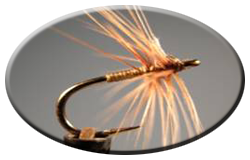
Materials:
- Hook: Daiichi 1640 or Drennon Specimen
- Hook Size: 12 to 16 (14 is best)
- Thread: Pearsall's Brown Silk, well waxed (until it turns black) ; black thread will work
- Hackle: cock starling feather taken from the back
Spiders are normally tied on a short shank hook with a straight eye. I find the Daiichi 1640 to be perfect for this style of fly; another is the Drennon Specimen hook. I tie them in sizes 12 to 16, but size 14 seems to be the magic number for taking fish. Traditionally, the fly is tied with Pearsall’s Brown Silk well waxed until it turns black, if you don’t have Pearsall’s, never fear, regular black thread will work. The hackle for the Black Spider is cock Starling feather taken from the back. That’s it, hook, thread and hackle.
Smash the barb on your hook and prep your hackle feather by removing the fluffy barbs from the base of the feather.
1. Mount your hook in the vise and start your thread with 3 or 4 turns behind the hook eye.
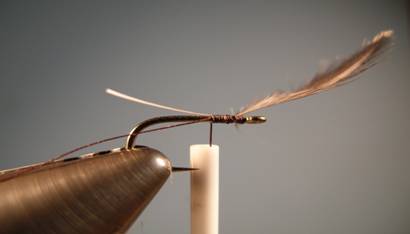
2. Tie in the hackle with the shiny side down and the feather tip pointing over the hook eye.
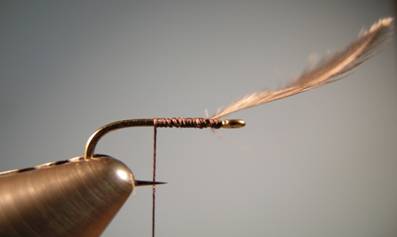
3. Bind down the hackle stem and tag end of the tying thread with 5 or 6 wraps in touching turns, and then clip off the hackle stem and tag tying thread.
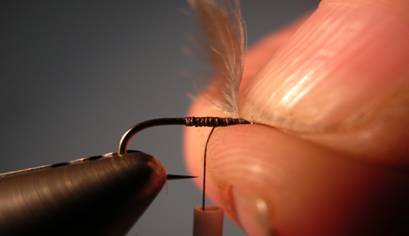
4. Continue to wrap the tying thread in touching turns toward the hook bend until you are even with the hook point. These are very short bodied flies. Wrap your tying thread back toward the eye in touching turns until you are ½ to 2/3 of the way back to the eye. Let the bobbin holder hang at this point.
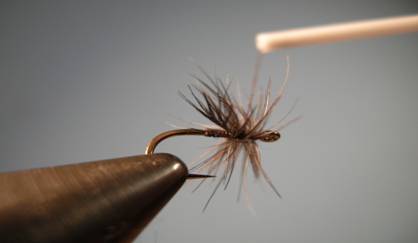
5. Bend the hackle stem to orient the stem for wrapping. With short Starling feathers, I prefer to use hackle pliers (specifically a rotary type hackle pliers), not fingers, for wrapping this hackle. Grasp the tip of the hackle and wrap one turn behind the eye of the hook then continue to wrap in open turns back to where the thread is hanging. I try to use as much of the feather as I can, usually 4 to 5 wraps. A word of caution here, Starling feathers are very fragile, handle with care.
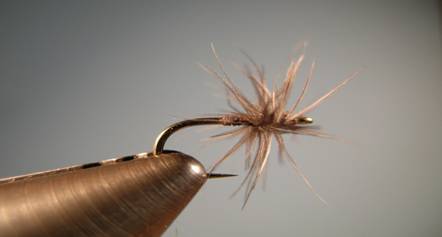
6. Catch the wrapped hackle with one turn of tying thread, and then spiral the tying thread back toward the eye of the hook in open turns. Wiggle the thread as you wrap through the hackle fibers to keep as many fibers free as possible. Taking these thread turns over the hackle will reinforce the hackle stem.
7. When the thread is back at the hook eye, use your finger to hold the hackle fibers back and make 2 wraps at the hook eye. This is usually enough to keep the hackle fibers out of the way. Whip finish the head and apply head cement, if you use it. If I’m using waxed silk, I don’t bother with head cement.
8. Break off or cut off the excess hackle tip.
This is not the original hackling method. Baillie, after tying in the hackle would wrap the feather around the tying thread, and then wrap the two materials back at the same time. Using the method above serves the same purpose and is easier for tiers new to spiders.
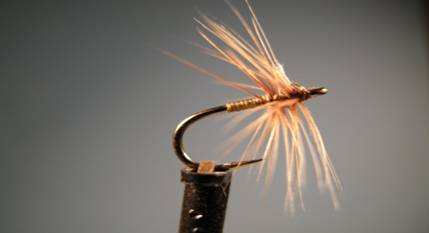
Baillie’s Red Spider
- Hook: Daiichi 1640 Size 14
- Thread: Pearsall’s Primrose Yellow Silk well waxed, or Olive tying thread (Yep, primrose yellow, when waxed turns a lovely translucent olive color.)
- Hackle: Reddish Brown hen hackle (Rhode Island Red is about right.)
r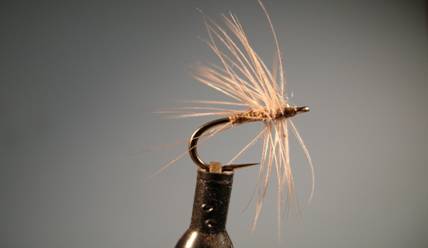
Baillie’s Dun Spider
- Hook Daiichi 1640 size 14
- Thread: Same as for the Red Spider.
- Hackle: Honey Dun Hen (Honey Dun has a gray list (center) with golden tips on the barbs) or Dun Hen. The Honey Dun hen hackle attracts more fish than the regular dun for some reason.
These spiders are best fished with an upstream cast and mend for a dead drift. Once the flies drift past your position, continue to fish them on the swing as you would a wet fly. While these flies will stay in or just under the surface film, a rising fly will often trigger a strike. The Baillie's spiders have been very good for me since I started fishing them and were effective enough to make a believer out of VEE.
For more great info, check out:
Fly Tying Terms
Beginning Fly Tying | Intermediate Fly Tying | Advanced Fly Tying.
